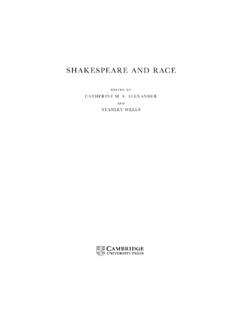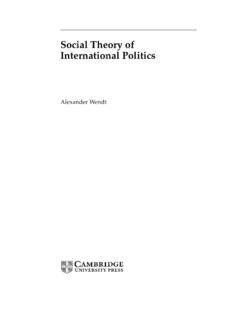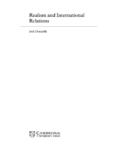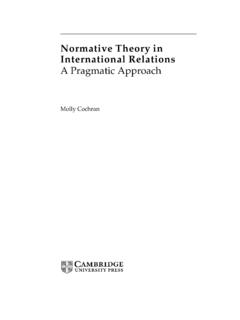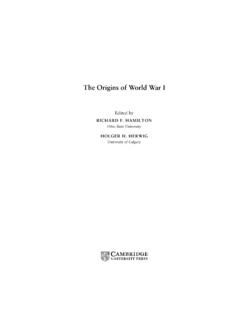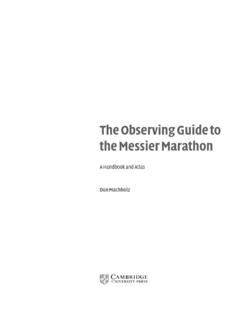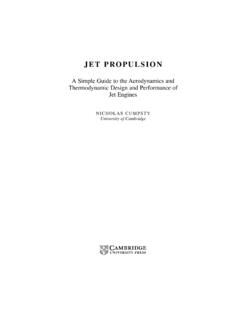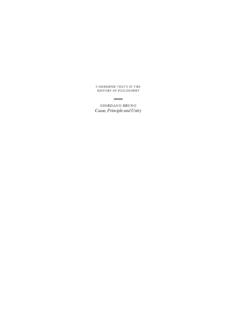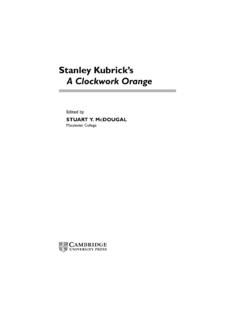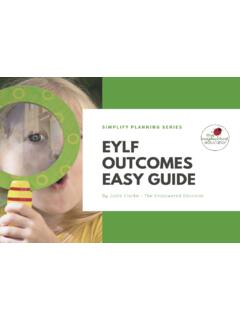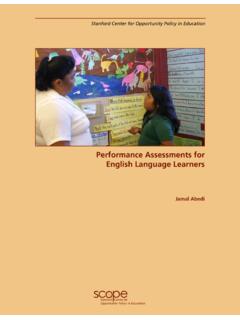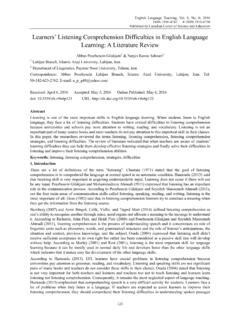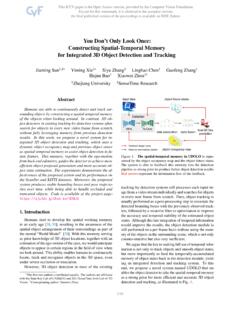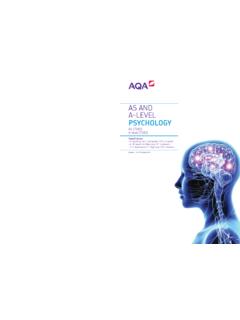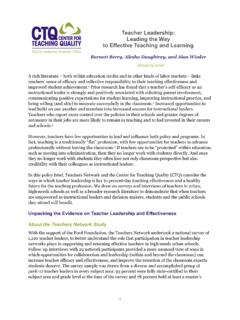Transcription of Testing for Language Teachers - Library of Congress
1 Testing for Language TeachersSecond EditionArthur Hughespublished by the press syndicate of the university of cambridgeThe Pitt Building, Trumpington Street, Cambridge, United Kingdomcambridge university pressThe Edinburgh Building, Cambridge cb2 2ru, UK40 West 20th Street, New York, ny10011 4211, USA477 Williamstown Road, Port Melbourne, vic 3207, AustraliaRuiz de Alarc n 13, 28014 Madrid, SpainDock House, The Waterfront, Cape Town 8001, South Cambridge University Press 1989, 2003 This book is in copyright. Subject to statutory exception and to the provisions of relevant collective licensing agreements, no reproduction of any part may take place without the written permission of Cambridge University published 1989 Second edition 2003 Printed in the United Kingdom at the University Press, CambridgeTypefaceSabon [od&i]A catalogue record for this book is available from the British Libraryisbn 0 521 823250 hardbackisbn 0 521 484952 paperbackviiAcknowledgementspageixPrefac exi1 Teaching and testing12 Testing as problem solving.
2 An overview of the book83 Kinds of tests and testing114 Validity265 Reliability366 Achieving beneficial backwash537 Stages of test development588 Common test techniques759 Testing writing8310 Testing oral ability11311 Testing reading13612 Testing listening16013 Testing grammar and vocabulary17214 Testing overall ability18615 Tests for young learners199 Contentsviii16 Test administration215 Appendix 1 The statistical analysis of test data218 Appendix 2 Item banking234 Appendix 3 Questions on the New Zealand youth hostels passage236 Bibliography237 Subject Index246 Author Index250 ContentsMany Language Teachers harbour a deep mistrust of tests and of starting point for this book is the admission that this mistrust isfrequently well-founded. It cannot be denied that a great deal oflanguage Testing is of very poor quality.
3 Too often Language tests have aharmful effect on teaching and learning, and fail to measure accuratelywhatever it is they are intended to effect of Testing on teaching and learning is known as backwash,and can be harmful or beneficial. If a test is regarded as important, if thestakes are high, preparation for it can come to dominate all teachingand learning activities. And if the test content and Testing techniques areat variance with the objectives of the course, there is likely to be harmfulbackwash. An instance of this would be where students are following anEnglish course that is meant to train them in the Language skills (includ-ing writing) necessary for university study in an English-speakingcountry, but where the Language test that they have to take in order tobe admitted to a university does not test those skills directly.
4 If the skillof writing, for example, is tested only by multiple choice items, thenthere is great pressure to practise such items rather than practise the skillof writing itself. This is clearly have just looked at a case of harmful backwash. However, back-wash can be positively beneficial. I was once involved in the develop-ment of an English Language test for an English medium university in anon-English-speaking country. The test was to be administered at theend of an intensive year of English study there and would be used todetermine which students would be allowed to go on to their under-graduate courses (taught in English) and which would have to leave theuniversity. A test was devised which was based directly on an analysisof the English Language needs of first year undergraduate students, and11 Teaching and testingwhich included tasks as similar as possible to those which they wouldhave to perform as undergraduates (reading textbook materials, takingnotes during lectures, and so on).
5 The introduction of this test, in place of one which had been entirelymultiple choice, had an immediate effect on teaching: the syllabus wasredesigned, new books were chosen, classes were conducted result of these changes was that by the end of their year s training,in circumstances made particularly difficult by greatly increasednumbers and limited resources, the students reached a much higherstandard in English than had ever been achieved in the university shistory. This was a case of beneficial (1968:5) once wrote that the good test is an obedient servantsince it follows and apes the teaching . I find it difficult to agree, andperhaps today Davies would as well. The proper relationship betweenteaching and Testing is surely that of partnership.
6 It is true that theremay be occasions when the teaching programme is potentially good andappropriate but the Testing is not; we are then likely to suffer fromharmful backwash. This would seem to be the situation that led Daviesin 1968 to confine Testing to the role of servant to the teaching. Butequally there may be occasions when teaching is poor or inappropriateand when Testing is able to exert a beneficial influence. We cannotexpect Testing only to follow teaching. Rather, we should demand of itthat it is supportive of good teaching and, where necessary, exerts acorrective influence on bad teaching. If Testing always had a beneficialbackwash on teaching, it would have a much better reputation amongteachers. Chapter 6 of this book is devoted to a discussion of how bene-ficial backwash can be last thing to be said about backwash in the present chapter isthat it can be viewed as part of something more general the impactofassessment.
7 The term impact , as it is used in educational measurement,is not limited to the effects of assessment on learning and teaching butextends to the way in which assessment affects society as a whole, andhas been discussed in the context of the ethics of Language Testing (seeFurther Reading).Inaccurate testsThe second reason for mistrusting tests is that very often they fail tomeasure accurately whatever it is that they are intended to know this. Students true abilities are not always reflected inthe test scores that they obtain. To a certain extent this is abilities are not easy to measure; we cannot expect a level ofTesting for Language teachers2accuracy comparable to those of measurements in the physical we can expect greater accuracy than is frequently are tests inaccurate?
8 The causes of inaccuracy (and ways ofminimising their effects) are identified and discussed in subsequentchapters, but a short answer is possible here. There are two mainsources of inaccuracy. The first of these concerns test content and testtechniques. To return to an earlier example, if we want to know howwell someone can write, there is absolutely no way we can get a reallyaccurate measure of their ability by means of a multiple choice testers have expended great effort, and not a little money,in attempts to do it, but they have always failed. We may be able to getan approximate measure, but that is all. When Testing is carried out ona very large scale, when the scoring of tens of thousands of composi-tions might not seem to be a practical proposition, it is understandablethat potentially greater accuracy is sacrificed for reasons of economyand convenience.
9 But this does not give Testing a good name! And itdoes set a bad few Teachers would wish to follow that particular example inorder to test writing ability, the overwhelming practice in large-scaletesting of using multiple choice items does lead to imitation in circum-stances where such items are not at all appropriate. What is more, theimitation tends to be of a very poor standard. Good multiple choiceitems are notoriously difficult to write. A great deal of time and efforthas to go into their construction. Too many multiple choice tests arewritten where the necessary care and attention are not given. The resultis a set of poor items that cannot possibly provide accurate measure-ments. One of the principal aims of this book is to discourage the use ofinappropriate techniques and to show that teacher -made tests can besuperior in certain respects to their professional second source of inaccuracy is lack of reliability.
10 This is a tech-nical term that is explained in Chapter 5. For the moment it is enoughto say that a test is reliable if it measures consistently. On a reliable testyou can be confident that someone will get more or less the same score,whether they happen to take it on one particular day or on the next;whereas on an unreliable test the score is quite likely to be considerablydifferent, depending on the day on which it is taken. Unreliability hastwo origins. The first is the interaction between the person taking thetest and features of the test itself. Human beings are not machines andwe therefore cannot expect them to perform in exactly the same way ontwo different occasions, whatever test they take. As a result, we expectsome variation in the scores a person gets on a test, depending on whenthey happen to take it, what mood they are in, how much sleep theyhad the night before.
